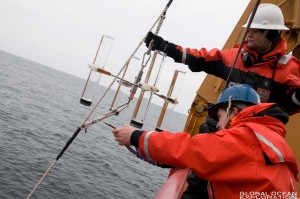Over the pipes, an announcement to get the small boats ready for launch came over in the early afternoon. It was time to retrieve the sediment traps that had been deployed the previous afternoon. Floating and drifting in the Bering Sea for 24 hours while the ship went about its other business, the sediment trap’s beacon had emailed the researchers, Roger Kelly from the University of Rhode Island and Jonathan Whitefield from the Bermuda Institute of Ocean Sciences, the current location of the instrument. The bridge had the bright orange buoy in sight and Roger Kelly was in the boat with the Coast Guard crew ready to retrieve it. This is easier said than done.Â
Deployment is simple enough as the collection tubes are set up and lowered into the sea after which the bright orange buoys are attached and lowered followed by the buoy that resembles a lobster buoy with a light on top and the satellite beacon. After the instrument is carefully deployed, it drifts about in the sea for 24 hours collecting sediment that falls from the surface. The traps are deployed in deep water (over 300 meters) and usually on the shelf break where there is a high degree of productivity. Â

“The sediment trap buoys adrift in the Bering Sea”
Â
Retrieval is more complicated. The small boats are launched into the rough waters of the Bering Sea where the crew must reach the trap and tow it closer to the ship where the winches can be used to bring the samples up carefully. Once the buoy is reached and towed, a line is thrown from the ship and secured to the trap, which is then carefully brought in. The great skill of the small boat operators and marine science technicians with the direction of the scientists makes the process go smoothly (most of the time).
 “The small boat making contact with the instrument and towing it towards the ship. Roger Kelly tends the buoy line.”
Â
“The instrument is about to come aboard as the small boat grabs a tender line from the ship.”
Â
On the most recent deployment, I was out on deck for the retrieval of the samples. When the first sample came up, it was filled with copepods and other critters. This was the surface sample where we would expect the animals to reside. The sediment sample collects in the bottom of the tube. This sample is then filtered and processed both on board and back at their lab to determine the amount of organic carbon in the water column. Once processed, the scientists are able to determine which organisms are contributing to the material which is made up primarily of animal waste and dead matter.
“The tubes with the samples are carefully collected by Jonathan Whitefield and MST Tiffany Wright for analysis.”
Â
“The surface collection tubes sometimes capture animals from the water column. In this tube, there are copepods and a ctenophore (comb jelly) amongst other small critters.”Â
Â
With the information learned from the sediment trap samples, the scientists are trying to put together pieces of the carbon cycle in order to find the flux of particulate organic carbon from the surface water into deep waters. Upper waters will draw down carbon dioxide into the water and convert it to organic carbon via photosynthesis. This carbon will then sink to the sea floor and could in turn draw down more carbon dioxide from the atmosphere which would be good for some of our problems but may cause harm to marine organisms. This project is seeking to find a baseline of what is happening in the system now so that in the future we will be able to measure the changes in carbon export in our changing world. Â
Â




